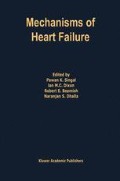Summary
Blood pressure (BP) measurement induces an alerting reaction that causes an increase of BP above the “basal” when it is measured in the clinic. The intensity of this elevation is function of many factors and decreases in subsequent measurements. Thus some individuals who have elevated BP values at a first “casual” determination have normal values at subsequent examinations. The present study was undertaken to investigate left ventricular (LV) function and structure in young individuals with a first elevated “casual” BP. In order to study this we separated two groups of young male individuals (average age 21 ± 0.6) from a previous screening in which BP had been measured at two different examinations separated by 1 week. Group A (n =12) had diastolic blood pressure (DBP) <70mmHg at both screenings (63 ± 2 and 62 ± 2mmHg, respectively), and group B (n = 9) had DBP 3≥90 mmHg at the first screening (94 ± 1 mmHg) but below these values at the second screening (76 ± 3 mmHg). Average age and body mass index were similar in both groups. Left ventricular function and structure were evaluated with echocardiographic and Doppler studies. None of the parameters measured was significantly different in any of the groups. The results provide evidence that young individuals who could be classified as hypertensives on a first screening and lose their condition at latter screenings do not present with LV dysfunction and consequently they should be considered normotensives according to the JNC-IV criteria.
Blood pressure (BP) measurement induces an alerting reaction that causes an increase of BP above the “basal“ when it is measured in the clinic [1,2]. The intensity of this elevation is a function of many factors that not only depend on the patient but also on the observer. This increase in BP diminishes on subsequent occasions [3]. Thus some individuals who have elevated BP values at a first “casual” screening have normal values at subsequent screenings [4,5].
The present study was undertaken to investigate left ventricular (LV) diastolic function in young individuals with a first elevated “casual” BP. It is known that diastolic alterations can be detected even before arterial BP is increased in normotensive individuals with a family history of hypertension
Access this chapter
Tax calculation will be finalised at checkout
Purchases are for personal use only
Preview
Unable to display preview. Download preview PDF.
References
Mancia G, Parati G, Panidossi G, Grassi G, Casadei R, Zanchetti A. Alerting reaction and rise in blood pressure during measurement by physician and nurse. Hypertension 9: 209–215, 1987.
Armitage P, Rose GA. The variability of measurements of casual blood pressure. I. A laboratory study. Clin Sci 30:325–335, 1966.
Mancia G, Casadei R, Gropelli A, Parati G, Zanchetti. Effect of stress on diagnosis of hypertension. Hypertension 17(Suppl III):56–62, 1991.
Pickering TG. Ambulatory Monitoring and Blood Pressure Variability. Pickering T.G. (Editor) Science Press, London 1991. pp 7.1–7.14
De Lena S, Rinaldi GJ, Almirón MA, Gende OA, Cingolani HE. Consideraciones sobre la definitión de hipertensión arterial a partir de un estundio de prevalencia en 1423 jóvenes. Medicina 52:119–130, 1992.
Grattinger WF, Neutel JM, Smith DH, Weber MA. Left ventricular diastolic filling alterations in normotensive young adults with a family history of systemic hypertension. Am J Cardiol 68:51–56, 1991.
Hypertension prevalence and the status of awareness treatment and control in the United States. Final report of the Subcommittee on Definition and Prevalence of the 1984 Joint National Committee. Hypertension 7:457–461, 1985.
Sahn DJ, De Maria A, Kisslo J, Weymann AE. Recommendations regarding quantitation in M-mode echocardiography: Results of survey of echocardiographic measurements. Circulation 58:1072–1083, 1978.
Devereaux RB, Reichek N. Echocardiography in detection of left ventricular mass in man. Circulation 55:613–618, 1977.
Ganau A, Devereaux RB, Roman MJ, de Simeone G, Pickering TH, Saba PS, Vargiu P, Simongini I, Laragh JH. Patterns of left ventricular hypertrophy and geometric remodeling in essential hypertension. J Am Coll Cardiol 19:1550–1558, 1992.
Teichholz LE, Kreulen T, Herman MV, Gorlin R. Problems in echocardiographic volume determination: Echocardiographic-angiographic correlations in the presence or absence of asynergy. Am J Cardiol 37:7–11, 1976.
Ko P, Boghner DR, Paulsen WJ. Rapid estimation of echocardiographic peak velocity of circumferential fibre shortening (peak Vcf)-Br Heart J 46:35–39, 1981.
Quinones MA, Mokotoff DM, Nouri S, Winters WL, Miller RR. Noninvasive quantification of left ventricular wall stress. Validation of method and application to assesment of chronicpressure overload. Am J Cardiol 45:782–790, 1980.
Quinones MA. How to asses diastolic function by Doppler echocardiography. In: Heart Disease, 3rd ed. Braunwald E (ed). Philadelphia: WB Saunders, 1992, pp 351–358.
Savage DD, Garrison RJ, Kannel WB. The spectrum of left ventricular hypertrophy in a general population sample: The Framinagham Study. Circulation 75(Suppl I):126–133, 1987.
Devereux RB, Lutas EM, Casale PN. Standardization of M-mode echocardiographic left ventricular anatomic measurements. J Am Coll Cardiol 4:1222–1230, 1984.
Birkett NJ, Donner AP, Maynard MD. Assessing hypertension control in the community: The need for follow-up measurements to ensure clinical relevance. Com Med Ass J 136: 595–600, 1987.
Miall WE, Brennan PJ. Observations on the natural history of mild hypertension in the control groups of clinical trials. In: Mild Hypertension: Natural History and Management. Gross F, Strasser T (eds). Chicago: Pitman/Year Book Medical, 1979, pp 38–46.
Carey RM, Ayers CR. Labile hypertension. Precursor of sustained essential hypertension? Am J Med 61:811–814, 1976.
Kaplan N. Clinical Hypertension, 5th ed. Baltimore, Williams and Wilkins, 1990, chapter 1. p 1–25
Editor information
Editors and Affiliations
Rights and permissions
Copyright information
© 1995 Springer Science+Business Media New York
About this chapter
Cite this chapter
De Lena, S.M., Escudero, E., Olano, D., Cingolani, H.E. (1995). Left Ventricular Mass and Diastolic Function in Young Individuals With a First Elevated “Casual” Blood Pressure. In: Singal, P.K., Dixon, I.M.C., Beamish, R.E., Dhalla, N.S. (eds) Mechanisms of Heart Failure. Developments in Cardiovascular Medicine, vol 167. Springer, Boston, MA. https://doi.org/10.1007/978-1-4615-2003-0_9
Download citation
DOI: https://doi.org/10.1007/978-1-4615-2003-0_9
Publisher Name: Springer, Boston, MA
Print ISBN: 978-1-4613-5827-5
Online ISBN: 978-1-4615-2003-0
eBook Packages: Springer Book Archive

